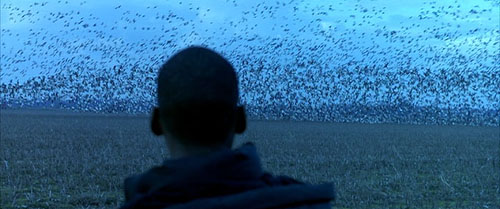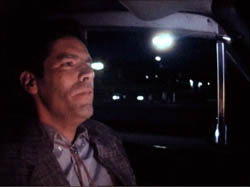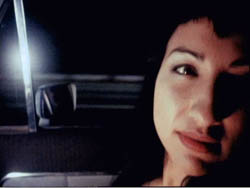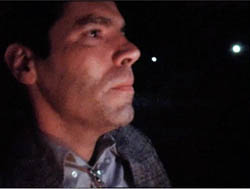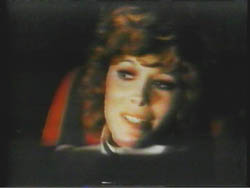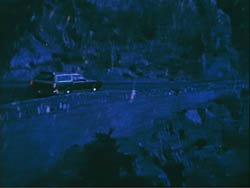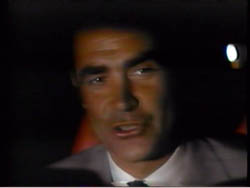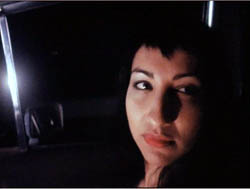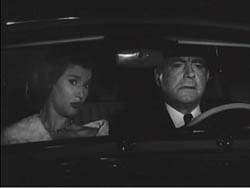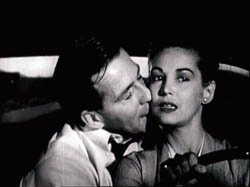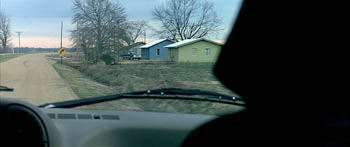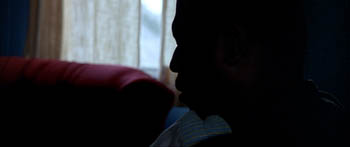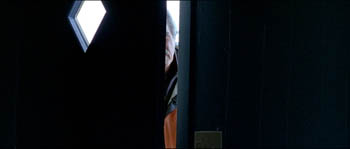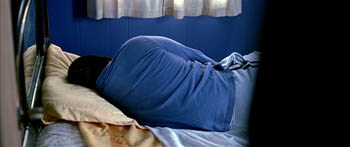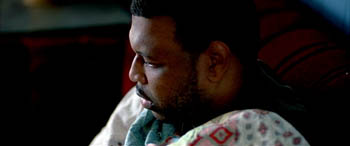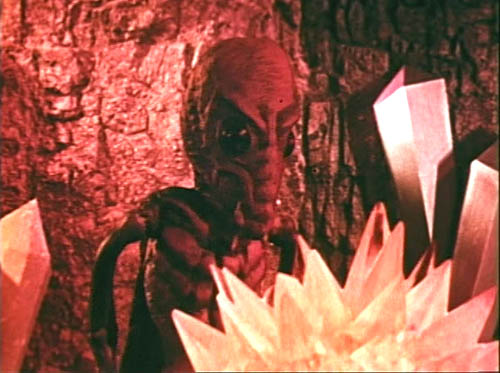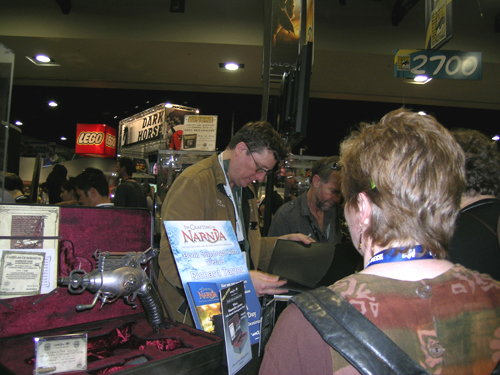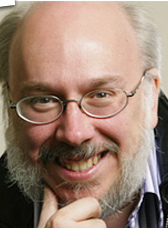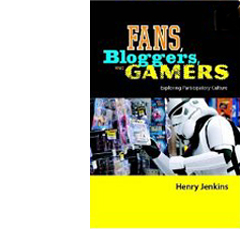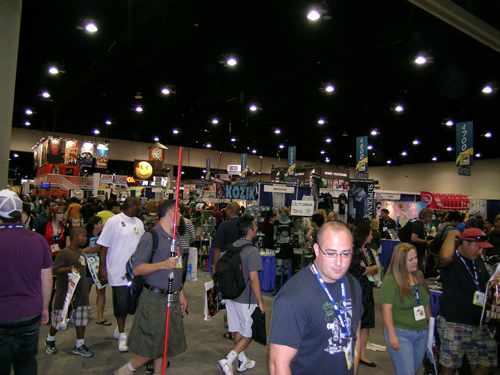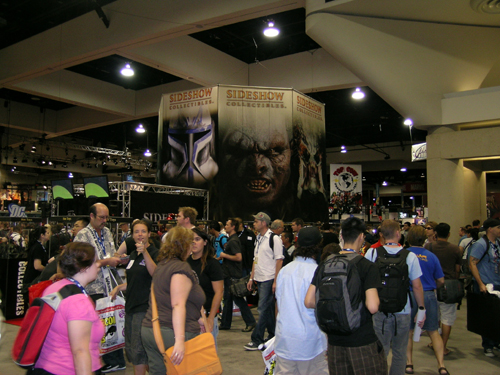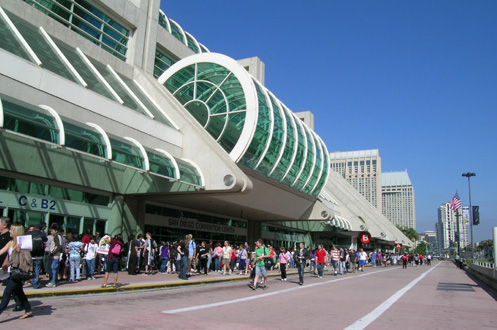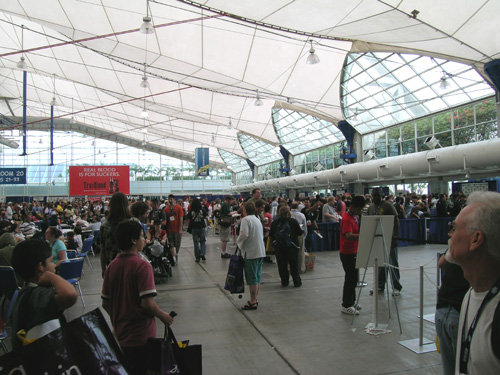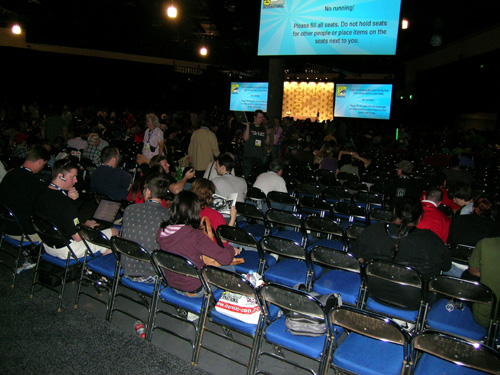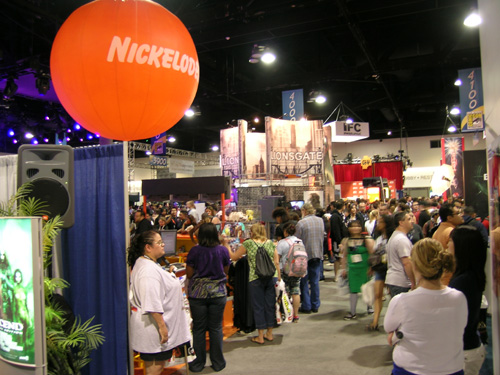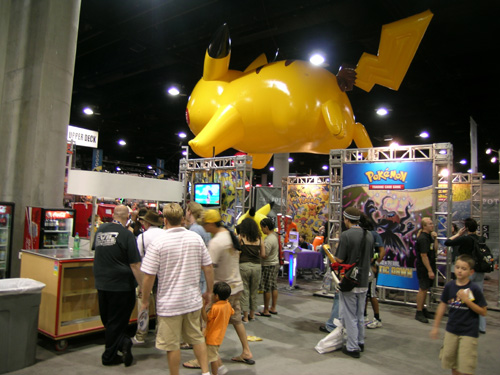Archive for the 'Festivals' Category
Dispatch from sunny Vancouver
Ballast.
After six days, plenty to report from the Vancouver International Film Festival. It has been unusually warm and sunny during our first week, but we have diligently spent most of our time in darkened theaters.
Kristin here:
Another country heard from
It’s a rare day when one gets to see a Haitian film. It’s an equally rare day when one gets to see a Jordanian film. On Monday I saw both, and the contrast between them could hardly have been greater.
Eat, for This Is My Body (Mange, ceci est mon corps, 2007), a Haitian/French co-production is Michelange Quay’s first feature. A Haitian-American, Quay received his MFA in directing at New York University.
The film’s opening is extraordinary, with a series of low-altitude helicopter shots beginning over the ocean and then moving rapidly across huge shanty-towns and finally into bleak mountain canyons in the country’s interior. After this passage of flight over bright landscapes, the bulk of the story takes place in and around a quiet, dark, nearly deserted colonial mansion somewhere in the countryside.
I’ve noticed that there seems to be a mini-revival of 1970s-style art cinema conventions. After many years in which art cinema tended to mean intricate psychological studies, a more challenging, formalist avant-garde seems to surface now and then. While watching Eat, for This Is My Body, it occurred to me that it could almost have been called Haiti Song, so strongly did it remind me of Marguerite Duras’s India Song. There enigmatic actions, often dancing, were staged in a colonial house. Eat, for This Is My Body’s action is, if anything, more enigmatic, though in this case the native population is present in the house in the person of a dignified manservant and a group of nine boys brought at intervals into the house, apparently as a treat.
The story is so minimal as to be non-existent. Apart from the nine boys, there are only three characters: an 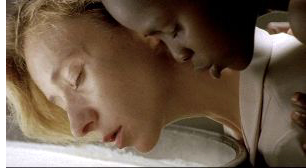 old woman, a young woman, and the black servant. Not until about 70 minutes into a 105-minute film are these characters identified, though only to the extent that the younger woman is revealed to be the daughter of “Madame.” There are hints of an erotic attraction between the daughter and the servant, though this comes to nothing. The daughter’s wandering through the local town, among the teaming population engaged in washing, selling, and other everyday activities suggests that she may be gaining some insight into native Haitian culture—but this, too, remains a mere hint. Ultimately, the film creates not a narrative, but an evocative narrative situation full of mystery. The film was shot on 35mm and creates a lovely, austere style for the scenes shot within the mansion.
old woman, a young woman, and the black servant. Not until about 70 minutes into a 105-minute film are these characters identified, though only to the extent that the younger woman is revealed to be the daughter of “Madame.” There are hints of an erotic attraction between the daughter and the servant, though this comes to nothing. The daughter’s wandering through the local town, among the teaming population engaged in washing, selling, and other everyday activities suggests that she may be gaining some insight into native Haitian culture—but this, too, remains a mere hint. Ultimately, the film creates not a narrative, but an evocative narrative situation full of mystery. The film was shot on 35mm and creates a lovely, austere style for the scenes shot within the mansion.
The Jordanian film, Captain Abu Raed (2007), takes a more familiar approach, centering around a likable, heartwarming protagonist. Raed, an airport janitor, finds an old pilot’s hat, and the children in his working-class neighborhood assume he really is a pilot. He plays along, less to feed his own ego than to inspire their imaginations through false tales of his adventures abroad. Gradually he becomes more involved in the lives of some of his listeners, and the film progresses from the sugar-coated tone of the opening scenes into a darker situation as Raed seeks a way to save the family of a violent neighbor.
Director Amin Matalqa was raised principally in the U.S., but he returned to his native country for this, his first feature. It is also the first feature film to come from Jordan in decades, and it reflects a slow but distinct movement into movie production in some of the Middle-Eastern countries where conservative religious views have long suppressed it. Captain Abu Raed is technically polished and makes considerable use of Amman cityscapes and ancient ruins as backdrops for the action. It’s also definitely a crowd-pleaser, judging by the sold-out audience I saw it with.
Another rarity is Australian director Benjamin Gilmore’s first fiction feature, Son of a Lion (2007), which he filmed entirely in the Peshawar region of Pakistan. That’s an area adjacent to the northwest border of the country with Afghanistan, notorious as a refuge for Taliban fighters and probably Osama bin Laden. The program lists Son of a Lion as an Australian/Pakistan production. I doubt any Pakistani funding went into it, but Gilmour wrote the script with the advice of the local people, and non-professionals play all the characters. The credits also contain quite a few Pakistanis performing tasks behind the camera.
The story seems inspired in part by the “child’s quest” narratives of the Iranian classics of Abbas Kiarostami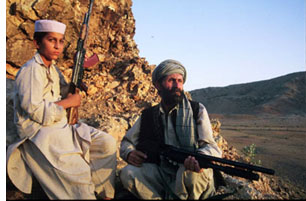 and Mohsen Makhmalbaf. A strict, traditionalist widower who makes guns wants his 11-year-old son to follow in the family business, while the boy longs to attend school. Apart from his father’s determined opposition, Niaz’s desires fly in the face of the local culture. Gun shops are everywhere, and every male adult seems to be armed. Shopkeeper casually step into the street to fire off weapons to test or demonstrate them. At one point the falling bullet from such random shooting kills a bystander. Between the personal scenes Gilmour intersperses occasional scenes of men sitting around and discussing the situation, debating whether they would shelter Bin-Laden if asked to or turn him in for the reward; they also speculate on America’s image of their part of the world.
and Mohsen Makhmalbaf. A strict, traditionalist widower who makes guns wants his 11-year-old son to follow in the family business, while the boy longs to attend school. Apart from his father’s determined opposition, Niaz’s desires fly in the face of the local culture. Gun shops are everywhere, and every male adult seems to be armed. Shopkeeper casually step into the street to fire off weapons to test or demonstrate them. At one point the falling bullet from such random shooting kills a bystander. Between the personal scenes Gilmour intersperses occasional scenes of men sitting around and discussing the situation, debating whether they would shelter Bin-Laden if asked to or turn him in for the reward; they also speculate on America’s image of their part of the world.
Son of a Lion was shot under difficult and dangerous circumstances on digital video (with post-production handled, amazingly enough, by Peter Jackson’s Park Road Post facility in New Zealand). The shots of the beautiful desert landscapes are not up to those we are used to from Iranian films, but they manage to suggest the grandeur of the area and to give a fascinating and humanizing insight into a region which the American government and media portray as merely a hotbed of terrorism.
Moroccan films are not quite as rare as these, but they’re certainly not common. As Burned Hearts (Morocco/France, 2007) was being introduced, I realized that the only other Moroccan film I had previously seen was by the same director, Ahmed El Maanouni. That had been Trances, a semi-documentary1982 film about a touring pop-music group. It was shown last year at the Il Cinema Ritrovato festival in Bologna, having been the first film restored by Martin Scorsese’s World Cinema Founda tion.
Burned Hearts was another film that seemed to transport me back to the 1970s art cinema. A young man returns to his childhood home after being educated as an architect in Paris. His tyrannical uncle is dying, and flashbacks present the painful memories evoked by the familiar sights and sounds of the city, this exploration of the character’s mental paralysis, along with the black-and-white cinematography of the locations, evokes both Duras and Antonioni. But El Maanouni refuses to concentrate solely on the hero’s concerns, bringing in several intriguing characters from the neighborhood and having groups spontaneously break into song and dance in the streets and shops.
Melodramas from Mexico
These films all come from regions seldom represented in international film festivals, but Mexican cinema 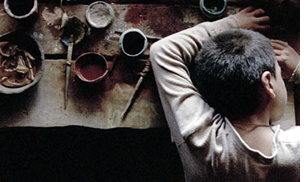 has had a growing presence in such venues in recent years. Two I’ve seen so far are very different from each other. The Desert Within (Desierto adentro, 2008), Rodrigo Plá’s second feature, already has a reputation after winning a cluster of prizes at the Guadalajara Film Festival. A period piece beginning in the late period of the Mexican revolution and extending into the 1930s, it tells the story of a peasant who inadvertently brings destruction on his village and decides that the only way to expiate his guilt is to drag his family far into the desert to build a church. The film takes a bitter view of Catholic guilt, with the protagonist forcing suffering, sexual frustration and death upon his children as his obsession grows.
has had a growing presence in such venues in recent years. Two I’ve seen so far are very different from each other. The Desert Within (Desierto adentro, 2008), Rodrigo Plá’s second feature, already has a reputation after winning a cluster of prizes at the Guadalajara Film Festival. A period piece beginning in the late period of the Mexican revolution and extending into the 1930s, it tells the story of a peasant who inadvertently brings destruction on his village and decides that the only way to expiate his guilt is to drag his family far into the desert to build a church. The film takes a bitter view of Catholic guilt, with the protagonist forcing suffering, sexual frustration and death upon his children as his obsession grows.
The other Mexican film, All Inclusive (2008), deals with another family crisis, but one which takes place over a few days in a luxurious resort on the “Mayan Riviera.” The story is slickly told by director Rodrigo Ortúzar Lynch and beautifully shot by Juan Carlos Bustamante, but I found the story forumulaic. A man who has just been told that he has only a short time to live, goes on vacation with his family, whom he has not informed of his condition. As he struggles with his secret, his wife and three children undergo their own crises. One daughter faces up to the fact that she is a lesbian, the son becomes entangled in an online “affair” with another man’s girlfriend, and the wife, assuming that her husband is being unfaithful, allows a young scuba instructor to seduce her—all this observed by the sardonic goth daughter.
As the tensions grow, a hurricane approaches, and the climactic set of revelations and reconciliations come just as it hits. During the narrative, each of the troubled family members manages to find someone gorgeous willing to bed them and/or hear their tales of woe. The idea that the bearish husband, seeking escape in a local bar, would run across a stunning 23-year-old Cuban woman who would take him into her home, listen at length to him, and finally, of course, teaching him to enjoy life. This gives him the courage to return to his family and tell them the truth. Once the family members have bared their soles, they become a jolly, well-adjusted bunch. It’s an entertaining story with likeable characters and touches of humor—but it’s a bit too much to believe.
Americans in Canada
Apart from Craig Baldwin’s Mock Up on Mu, which David will cover, I’ve seen two American indies so far. Momma’s Man (2008) is directed by Azazel Jacobs. It deals with Mikey, a man traveling on business who has problems with his flights and ends up staying with his parents in their New York loft. Finding excuses not to return to his wife and baby in California, he fritters away his time by reverting to his childhood pursuits. The film takes the daring step of being centered on an unsympathetic character who is the point-of-view figure for all but a few scenes. It manages to convey his gradual move from indecision to obsession and eventually a full-blown breakdown in a believable fashion.
Part of the appeal of Momma’s Man comes from the fact that Mikey’s parents are played by Ken Jacobs, the great experimental filmmaker, and his artist wife Flo Jacobs. It is set in their actual New York loft, a maze of odd filmmaking devices, accumulated pop-culture artifacts, and artworks. The two give extraordinary performances, managing to seem wise and caring and at the same time obsessive and eccentric to a degree that might have contributed to Mikey’s breakdown. Although Jacobs cast an actor as Mikey, one has to suspect that the film is at least somewhat autobiographical, and the casting of his parents has created a uniquely convincing portrait of a family.
David and I were delighted to see RR (2007) on the program. It’s the latest feature by American avant-gardist James Benning. Jim is an old friend, having been a graduate student in our department at the University of Wisconsin-Madison during our early years there. He has concentrated largely on landscape films, usually consisting of lengthy, static shots. This one consists wholly of distant views of trains in what appear mostly to be western and Midwestern locations. In virtually every case the shot holds until the entire train has moved through the shot or out of sight—or stopped, in a few cases.
As so often happens with structural films, small variations become evident to the alert viewer. A shot of a 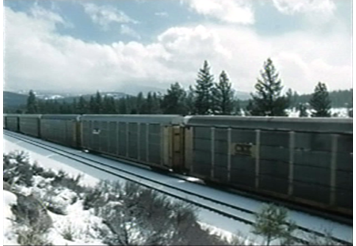 car stopped for a train passing through a small town contains tiny reflections in the windows of a nearby house that may draw the eye. Some trains are covered with spray-painted graffiti, while others are pristine. One is led to speculate about what the cars may be carrying, and there is a hint of social comment in that activity. A considerable portion of most of the trains consists of tankers, presumably carrying the gasoline or other petroleum products that are currently causing so much trouble in our economy. Others contain numerous livestock cars, and one lengthy train contains nothing else. Among the views of many freight trains, we are treated to a glimpse of a single very short passenger train zipping through the briefest shot in the film.
car stopped for a train passing through a small town contains tiny reflections in the windows of a nearby house that may draw the eye. Some trains are covered with spray-painted graffiti, while others are pristine. One is led to speculate about what the cars may be carrying, and there is a hint of social comment in that activity. A considerable portion of most of the trains consists of tankers, presumably carrying the gasoline or other petroleum products that are currently causing so much trouble in our economy. Others contain numerous livestock cars, and one lengthy train contains nothing else. Among the views of many freight trains, we are treated to a glimpse of a single very short passenger train zipping through the briefest shot in the film.
RR draws us to enter into perceptual play, often with a distinct touch of humor. Few of Jim’s films have contained the measure of their shot length in their mise-en-scene so decisively. The length and speeds of the trains determine the duration of the shots, and one learns to watch for the number of engines pulling or pushing a train as an indicator of how long the train is likely to be. A few shots show trains moving slowly and decelerating at an almost imperceptible rate, teasing us as to whether they will stop altogether and whether the shot will end if they do. At times a train may move through the shot, only to reveal another on a parallel track. One shot plays a very clever game with us. I won’t reveal what it is, but the shot comes perhaps a third of the way through: an oblique view along a track with bushes prominently in the foreground and a short, arched underpass in the middle distance.
Jim has continued to shoot in 16mm in an increasingly digital age, and he consistently manages to make gorgeous images that look more like 35mm. The last one of RR, involving a vast wind farm, is a stunner.
Captain Abu Raed.
David here:
An unusually good VIFF, with many films to get your eyes open.
Enter the Dragons, with Tigers
As usual, the venerable Dragons and Tigers thread is offering some remarkable new films from Asia. The Good the Bad the Weird lived up to its reputation, not to mention its title, offering frenetic action and comic-book (in the good sense) bravura. Sell Out!, a Malaysian satire of corporate maneuvering and media brainwashing, doesn’t get points for subtlety—the goliath is called the FONY corporation—and sometimes it tries too hard. Still, it’s likeable enough, and the fact that it’s a musical adds a welcome bit of froth. The funniest bit, for me, was the opening parody of an art movie, which does actually get integrated into the main action.
Two late works by long-time Japanese directors offered a study in contrast. Kitano Takeshi’s Achilles and the Tortoise starts out sweet and ends very sour, not to say bitter. In telling the story of a boy whose spontaneous love of drawing is forced into narrow commercial channels, Kitano suggests that art is a racket. Across the decades, schools and galleries push the pliant, nearly comatose young artist to create a signature style. He is told to be original, but also he must harmonize with fashion and tradition. With a grim obstinacy he tries to fulfill what the business demands, and to the end he is still trying.
Achilles is less willful than Takeshis’ and Glory to the Filmmaker!, and it tells a more coherent tale, but their glum narcissism is still in evidence. The film cries out for an autobiographical interpretation: is the naïve filmmaker corrupted by exposure to international art cinema? Pictorially, there’s some confirmation of this: Kitano seems to have abandoned his early films’ ingenious use offscreen spaces and planimetric compositions. Like his hero, who can’t achieve artistic singularity, Kitano has become a surprisingly academic and anonymous stylist.
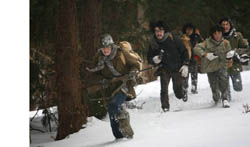 One can’t claim high originality for the style of Wakamatsu Koji either, but at least United Red Army has a gripping premise. The 1960s student movement was driven by opposition to the war in Vietnam and Japan’s cooperation with US policy, but in the following decade some factions emerged that were committed to violent revolution. Small cadres sequestered themselves in mountain cabins. Their exercises in “criticism and self-criticism” devolved into games of increasingly murderous aggression.
One can’t claim high originality for the style of Wakamatsu Koji either, but at least United Red Army has a gripping premise. The 1960s student movement was driven by opposition to the war in Vietnam and Japan’s cooperation with US policy, but in the following decade some factions emerged that were committed to violent revolution. Small cadres sequestered themselves in mountain cabins. Their exercises in “criticism and self-criticism” devolved into games of increasingly murderous aggression.
Wakamatsu’s technique is unstressed: No fancy angles, neverending tracking shots, or virtuoso compositions, just a businesslike application of today’s wobbly handheld look. The cunning lies in the film’s structure. After a half-hour montage summarizing the formation of the group, we are carried into the hideouts and watch the punishment grow more feverish and self-destructive under the domination of two leaders who seem parallel to Mao and Madam Mao.
By the end of the second hour, the remains of the army are on the run, struggling through vast snowy landscapes. Soon four survivors straggle into a ski lodge, hold the owner’s wife hostage, and face their final challenge: wave after wave of police assaults. Waiting for the inevitable outcome, the survivors spare time for grim humor: On 28 February one remarks, “I’m glad the all-out war won’t be tomorrow. Then my death anniversary could come only every four years.” And they can pause for an exercise in political discipline. After a lad takes an extra cookie, he criticizes himself. Stern reprimand follows: “That very cookie you ate is an anti-revolutionary symbol.” Unsentimental and unsparing, United Red Army is over three hours long, with not a longueur in sight.
A man parks his car to pick up some cake at a bakery. He has been away from home all night; now he’s rude to the lady behind the counter. Having bought a couple of cakes, he finds that a sinister black car has double-parked and hemmed him in. His efforts to find the owner lead to a spiral of comic and pathetic confrontations with an orphan child, burly Triads armed with whitewash, and a pimp with a distinctly bad haircut.
Creating something of a network narrative, Chung Mong-hong’s Parking in its modest way offers a cross-section of Taiwanese society, from the prostitute brought over from China to a jaunty barber who more or less controls the switch-points of the story. The ending will strike some as dovetailing all the cards a little too smoothly, but I found it satisfying, if only because it lets our haughty hero show unexpected resilience and compassion. This is only Chung’s second feature, but his work bears watching.
For once, it really is rocket science.
If you’ve already figured out the deep connections among Scientology, the aerospace industry, ritual sex magic, New Age spirituality, and the migration of Los Angeles hipsters to San Francisco in the 1950s, Mock Up on Mu won’t come as news. If, like me, you haven’t the faintest idea about the cat’s-cradle ties among these cultural phenomena, Craig Baldwin’s latest collage-essay-epic-lyric-narrative (all terms he applies to it) is the very thing you need. It’s as exuberantly peculiar as his earlier work like Tribulation 99 and Spectres of the Spectrum, flooding us with a relentless voice-over that splits off from and reconnects with the torrent of images grabbed from all manner of movies.
These earlier films had stories of a sort, swollen conspiracies and ominous coincidences that make Baldwin the eccentric cousin to Fritz Lang. But Baldwin says that these stories couldn’t really engage people, couldn’t get them to identify. Mu tells a more personalized tale. L. Ron Hubbard, founder of Scientology, has colonized the moon and sends Agent C to earth to arrange for people to be shipped up. Agent C runs afoul of Lockheed Martin, corrupt aerospace executive, and becomes attached to Jack Parsons, an early rocketeer who in the 1950s assumed the secret identity of Richard Carlson, so-so Hollywood actor. Meanwhile, Aleister Crowley rules a secret society at the center of the earth….
Or maybe not.
Actually, I won’t swear to much of what I just said. Baldwin’s phantasmagoria tests my memory, as well as plausibility. The story line is swallowed up by what he calls footnotes—swarming digressions, tangents, and flashbacks which are conjured up in imagery that shoots off in a dozen different directions. A few frames from a kiddie science movie or a grade-Z space opera, juxtaposed to Parsons’ rapid-fire account of the history of rocket testing, whiz by almost subliminally.
In any case, there are characters and a more or less linear story. But Baldwin is Baldwin, so things can’t be so simple. He has for the first time staged and shot footage of actors, and their scenes form a sort of string that you can follow. But just as crystals grow in fantastic array along a string, alien footage exfoliates out from the staged scenes. Baldwin aims, he says, at “a dialectical density.”
The result is a narrative experiment I’ve never seen before. With a simple cut, our characters are replaced by figures from other films, who become, in some spectral fashion, both alien inserts and our characters.
Confused? Here’s an example. Agent C (who will turn out to be Marjorie Cameron, muse of many West Coast artists) is riding with rocket scientist Jack Parsons. A series of shots shows them in the car’s front seat.
As the scene goes on, one character gets replaced by another.
Eventually both of our originals have been replaced.
The stand-ins can even change position as the dialogue continues uninterrupted (but always mis-synchronized).
The cuts make the inserted characters surrogates or avatars for our people, but they retain wisps of their original, enigmatic existence. They also remind us that situations like driving in a car are genre stereotypes, schemas so common that individual instances can serve as place-holders for one another. Yet the shots always return to the original actors, anchoring the associations and keeping at least one plane of the narrative moving forward.
These phantasmagoric shifts make the identity transformations in I’m Not There look labored. In Mock Up on Mu Baldwin may have found a new method of cinematic storytelling. Don’t expect Hollywood to pick it up soon.
Pulling half away
How do you tell your audience what it needs to know to understand what it’s seeing, and what it will see? A film can handle exposition (aka backstory) in several ways. Most films favor concentrated and preliminary exposition: Most information is given in one spot and quite early on. This is when you get the opening dialogue when characters say to one another: “Look, you’re my sister. You can tell me.” (Ohh…They’re sisters.) Concentrated, preliminary exposition is usually clunky, but it can be done with finesse, as in the opening soliloquy of Jerry Maguire.
The major alternative is distributed exposition, where information about the backstory is spread out, evenly or unevenly, across the film. This is common in mystery films (as when, under pressure, characters start to confess their relation to the murder victim) and in “puzzle films” like Memento, where we only gradually understand the relations among the characters. Delayed and distributed exposition in straight dramas is common in European art cinema, but it’s rare in the US, although independent films like Claire Dolan and Man Push Cart have made good use of the technique. Kristin already mentioned a similar strategy at work in Eat, for This Is My Body.
Lance Hammer’s Ballast comes garlanded with praise from festivals and major news outlets like the New York Times. For once the advance word is justified. I thought that Ballast was an exceptional intimate drama, focused almost entirely on three people and their layered relationships in a country town in the Mississippi Delta.
At this point I should mention how the three principals are connected, but part of the daring of Hammer’s film is to postpone, for almost an hour, telling you such things. He says he wanted a film that is, like the Delta, “spacious and quiet and slow.” Here the very issue of what we need to know is put into question. By blocking our knowledge of characters’ relationships, Hammer forces us to confront moments of action in a pure state. Each instant, each shot even, gains an integrity and gravity it wouldn’t have if we knew the full dramatic context.
Take the opening. After a brief, wordless prologue showing a boy in a field of crows, we’re in a vehicle pulling up at a bungalow.
The indistinct figure of a man goes to the door. Inside, a brief shot shows a black man’s face in silhouette.
Soon, the first man, who is white and weatherbeaten, is seen at the door, expressing concern for the man inside.
The white man enters, wrinkles his nose at a smell, and proceeds to another room, where a figure, turned from us, lies on a bed.
The black man continues to sit impassively before his TV, though now we can see his face more clearly.
Who are these men? What connects them? Who has died? An ordinary film would tease us with these questions but answer them fairly soon (say, in the next three or four scenes). Here, we will have to wait a considerable time to find out the answers. In the meantime, what we have registered in place of an action arc is the atmosphere of shock, sorrow, grieving, and lowering skies. And almost immediately a rather dramatic event will occur, nearly offscreen, and its causes will remain equally opaque for quite some time.
Ballast’s delay in spelling out its story premises is sustained by two unusually quiet main characters. Lawrence, the man sitting in the darkness, leads a solitary life and speaks reluctantly and briefly. Likewise, the boy James is often silent or alone. These two don’t soliloquize, and they live one day at a time. We must simply observe their behavior, try reading their minds, and more generally absorb the emotional tenor of their lives.
The sparseness of the exposition also puts us on the alert for any scrap of information that will fill in the blanks. For instance, references to “the store” flash out as clues to possible connections among the characters. Hammer’s strategy demands that the audience exercise a degree of patient concentration that most films never ask for.
For roughly the first half of the film, then, Hammer’s narrational technique creatively impedes our full understanding of the basic givens of the story. Once the relationships have coalesced (though there are still some revelations to come), the dialogue becomes more explicit and, some would say, the drama more traditional. But the visual narration continues to mute and elide dramatic moments. At some points pieces of action are rendered opaque by the bobbing, jump-cut camerawork. Most memorably, a clumsy embrace is hidden by a “wrong” camera setup, all the better to make us wonder about the impulses behind the gesture. Hammer matches his oblique plotting with an oblique visual style.
Hammer has cited Bresson as an inspiration, and in conversation he also mentioned late Godard, who has become willing to avoid exposition for nearly an entire film. Unlike Godard, who seems to revel in the pure artifice of withholding information, Hammer appeals to realism: The gradual piecing together of the narrative, he remarked to me, is like our coming to know people in life, bit by bit.
Correspondingly, by the end of Ballast we come to feel more empathy for Hammer’s characters than for Godard’s, and possibly even for most of Bresson’s enigmatic souls. But the empathy doesn’t come cheap, and it isn’t wallowed in. The climax is brushed past in one sideswiping shot; blink and you’ll miss it. In another interview, Hammer speaks of “putting something out and pulling half away.” By leaving us to fill in that half, Hammer exhibits his respect for his characters, and for his audience.
Mock Up on Mu
P. S. For dispatches from 2006 and 2007 editions of the VIFF, type Vancouver into our search box.
Comic-Con 2008, Part 3: Two newbies share thoughts
Autographs are big: Richard Taylor signing books about the designs for The Chronicles of Narnia
Kristin here–
Back in the early days of this blog, I posted an entry on our friend Henry Jenkins and his concept of the “aca/fan,” a scholar who studies fandoms while being a fan him- or herself. At that time his book Convergence Culture: Where Old and New Media Collide, had recently come out, and I highly recommended it. Fortunately the book has had a well-deserved success. On October 1 it will be coming out in paperback.
In that entry, I described Henry and our long friendship with him:
Henry doesn’t study fans to find out what makes them tick. He knows that. He’s one of them, a participant in fan cons, a player of video games, an explorer of the multimedia sagas like those of Star Trek and The Matrix that have grown up in the age of franchise culture. He received his doctorate here at the University of Wisconsin-Madison, where David was his dissertation advisor, and we have followed his career, as they say, with great interest. Straight out of the gate he was hired by MIT, where he is now the Director of the MIT Comparative Media Studies Program and the Peter de Florez Professor of Humanities.
(You can find Henry’s blog, “Confessions of an Aca/Fan,” here. He interviewed me when The Frodo Franchise was published; you can find that in three parts, here, here, and here.)
The Frodo Franchise dealt with fan culture as well in Chapter 6, on fan-originated websites. Convergence Culture deals to a considerable extent with modern transmedia franchises. Yet neither of us had ever been to that Mecca of fandoms, Comic-Con. Of course, this year, when I got invited to participate on TheOneRing.net’s panel on the Hobbit project, I accepted. I emailed Henry just in case he happened to be going as well. It turns out he was, being on a long driving vacation through the west with his wife and son.
At first I thought maybe we could meet up early in the Con and then get together afterwards and share our impressions. (We bloggers look for material anywhere we can find it, and this seemed like a golden opportunity.) In fact we didn’t meet early on. There was so much going on, and we never glimpsed each other in the course of the entire event—not surprising, really, when you consider its size. But I made cell-phone contact on Sunday, and we sat down in my hotel lobby and spoke our thoughts into a microphone. Here are some excerpts.
(We talk about what we went to—him to the TV previews, me to artists’ presentation.)
On Different Tracks
We started off by talking about what we had each concentrated on.
HJ: It’s very clear that it’s like six or seven different conventions I could have gone to in the course of the weekend, and it would be a totally different experience depending on which one you went to.
KT: Yeah, I had that impression that there were probably people here mainly to buy stuff, some people here mainly to see celebrities and get autographs and so on.
HJ: And even on that there was a split between the film and the TV people. And there’s a whole comics track. Under other circumstances I would have just been spending my entire time at comics panels, because they’re the strongest comics sessions anywhere in the country.
Coming Alone vs. Having Something Specific To Do
KT: I was happy that I had something to anchor myself, though. I don’t think I’d like to come here, at least for the first time, alone and not having anything specific to do.
HJ: Luckily Henry and Cynthia were along, but it was overwhelming a bit, trying to negotiate and keep up with three people in a space that congested. So that was its own kind of challenge. Sometimes I was thinking it would be great just to be a single person navigating through the space and not have to have large-scale logistics! The scale of it just blows you away. I’ve been on the floor at E3, which is supposed to be one of the largest entertainment trade shows. I’ve done South by Southwest. But neither of them are anywhere near the scale of Comic-Con.
The Scale of the Event
KT: They always say 125,000, because that’s the number of tickets they sell, but then you’ve got all the exhibitors and the people who are presenting on panels. It must be another few tens of thousands packed into that building.
HJ: Yeah, at least.
KT: I was kind of amazed that it worked as well as it did
HJ: Yeah, they did a remarkable job in just managing crowd control. Getting people in and out of things with some degree of order. Some more bullying guards than others, but it was probably necessary to keep the peace.
KT: Yeah, there were a LOT of guards and guides and so on, but people seemed really to be polite, on the whole. I was taking the shuttle bus from a hotel down the street [from my hotel] every day and then coming back by shuttle bus. This morning the bus was quite late compared to other days. It was supposed to come every ten minutes, and we were there maybe twenty. And people who were arriving made this very neat horse-shoe shaped line on the sidewalk. It was very orderly.
HJ: Almost no signs of anyone breaking in line, despite the intensity of some people’s desire to get into things. Someone commented behind me about ‘honor among geeks,’ and that’s probably a good description. There’s a strong honor code.
KT: The venue seems to be up to having that many people in it. I hardly had to wait for rest rooms at all.
HJ: No, the facilities are good.
We ended up doing a fair amount of what they call here “camping,” which is sitting in several panels in a row because there was something we really wanted to see. But you end up trapped in a space with no access to food. Hall H at least has rest-room facilities in the space.
KT: I didn’t try that myself, that is, camping. But I was going to this action-figure panel because it involved Toy Biz, which did the action figures for Lord of the Rings. I heard from people in line that a lot of them were there for the next panel, which was on Sanctuary, which I know from nothing, but they were very devoted and were saying, “They shouldn’t have put this in such a small room.”
HJ: There is a certain sense that you vote with your body at Comic-Con. One of my newest fandoms is Middleman, which is a new ABC family show, and it was in a small room, but we packed it. There was a sense of accomplishment. The producer looked out and said, “This may be the whole audience for the show,” because it hasn’t gotten much publicity yet. There was a sense that just being there was show of support for things.
KT: I wonder how many of the companies have people at those panels—in the audience. I hadn’t realized it, but there was somebody from New Line—who’s probably not from New Line anymore—and then some Warner Bros. people, supposedly, sitting out in the audience for the Hobbit one. That kind of surprised me. Why bother?
HJ: At the larger sessions it seemed they had blocked off four or five rows of space just for the studio people. Rarely were they occupied to anywhere near that extent, so it was maybe overkill. But there were a few sessions where there were a significant number of people. The Battlestar Gallactica, for example. There was a large studio contingent there for that. Suits and friends and family and other writers, because that was a kind of last hurrah for that production. They just wrapped shooting the last episode two weeks ago, so this would have been a major last gathering of a lot of those people. They said they really hadn’t had a chance to have a wrap party yet, so in a sense it probably was.
The Hall H Experience
KT: Did you have the Hall H experience at all?
HJ: We went to see Heroes one morning, which was the first time, they said, a TV show had made it into Hall H. We managed to be there for Watchmen and a few of the other movies that followed it.
KT: I kind of avoided it for a while because I kept hearing that there would be incredibly long lines, and I pictured just sitting there for hours and hours and hours reading and possibly not getting into what I wanted to see anyway. So I avoided it until yesterday [Saturday], and I went to the Terminator Salvation one. I wanted really to go to the Pixar one, so I went to get in line very early, and ended up getting in on time for Terminator Salvation.
HJ: Well, for Heroes we waited for about an hour outside and then got in. Then there was a fairly long wait to get started, but then we knew that there were several things after that that we wanted to see as well.
KT: And was it full?
HJ: It was packed. But Heroes has been a kind of success story of Comic-Con. They showed the pilot there before it debuted, and Heroes is pretty desperate at this point to rekindle fan enthusiasm. Last season is largely seen as a bust. Hence their decision not to come back from the strike. They did a partial season and put it off to the fall, because the ratings were plummeting and they were getting bad buzz from fans. So they wanted to come back this year with a killer. They showed the entire opening episode, which was definitely a fan-pleaser. They had figured out what had gone wrong the first season and had put together something that was going to please. So there was lots of extended applause at key moments. It’s kind of fascinating to watch an episode of a TV show with 6500 other people.
The Exhibition Hall
KT: I only discovered the comics section today, as I was about ready to leave, because I hadn’t really been aware of which sections were devoted … I sort of thought it was all random, but obviously they do devote one big section to all the people who are selling old comic books. I suppose you could just stay in one part of the hall and never see the rest of it.
HJ: I felt I barely made a dent in the hall. The first day I didn’t quite realize how big it was, so I was just going up every aisle, and the second and third day I was going on targeted missions. But it still was just so immense that there’s no way you could see it all.
KT: And it’s SO congested.
HJ: Especially if you get to the studio side of things.
Autographs and Planning
KT: I could not figure out what was going on at the Warner Bros. exhibit, but they were constantly surrounded by lines and lines and lines of people who were obstructing the aisles around them. I guess they had people from their TV shows signing.
HJ: They seemed to. I kept stumbling into people. You wander around one corner and there’s Peter Mayhew of Chewbacca fame sitting there, and Will Frakes suddenly would pop up at another table. Neither particularly advertised. Then there were all the advertised autographed stuff. There were a lot of people there that you would know in another context.
KT: I don’t know how you would find out about all of those things in advance. I don’t think Lynda Barry was listed in the program as doing autographs, but she was at the Drawn and Quarterly booth at certain times. I missed her entirely. I got her autograph because I was sitting in the audience before her presentation and she sat down beside me.
HJ: They seemed to have a certain number of people who were there to do autographs, but then there were all these other people randomly. I guess you had to follow a particular company and maybe they posted on the Web.
KT: Yes, I was doing autographs at certain times for my book, and it was just on TheOneRing.net and The Frodo Franchise [websites]. You have to really investigate, go in with a plan.
HJ: It seems to be the case: The more you plan, the more you can get out of the experience.
KT: We were selling copies of my book at this very small booth, and I was there for an hour at different times of day on three days. I think almost everyone, if not everyone, who bought a copy came to the booth specifically to buy it. There were no impulse purchases. I don’t think people buy books at Comic-Con.
HJ: I looked at comics while I was there, but I would buy them from my dealer back in Boston or online at Amazon or My Line Comics [?]. Why I would weigh my suitcase down with comics in the age when it’s so easy to buy stuff digitally?
KT: Not new ones.
HJ: Not new ones. Collectibles, sure.
KT: Unless you have them signed.
Fan Culture hangs on at Comic-Con
HJ: Usually the cons I go to are small-scale, very intimate, you know a high number of the people who are coming. It’s fan-driven and fan-focused. This was like Creation Con on steroids!
KT: Though technically speaking, it is run by fans; there’s a committee.
HJ: It is, and they had a really bad art room with lots of cat pictures and dragon pictures and wolf pictures, which gave it a sense of fan authenticity, because they hadn’t closed out the really bad fan art, even in the midst of all the commercial takeover.
KT: Well, I missed that one.
HJ: You didn’t miss anything, other than the reaffirmation that this was still a con. There were still places and niches and corners where the fan stuff still ruled. You wouldn’t see fanzines there, but then you wouldn’t see them at most fan-run cons these days, since everything’s moved to the Web.
KT: Well, there’s Artists’ Alley, which is way over in the corner. That seems to be fans who are aspiring to be pros but haven’t really made it yet.
HJ: Well, it was a mix. I mean, you’d see Paul Chadwick there [author of “Concrete” series, published by Dark Horse Comics] or Kim Deitch [author of graphic novels such as The Boulevard of Broken Dreams and Shadowland], who were independent and weren’t necessarily going to be there with a company, but yeah, it’s definitely a lot of wannabes in some of that space.
And then fans show themselves through costumes. For all the jokes about women in Princess Leia costumes—and I saw maybe a dozen Princess Leia slave-girl outfits—it was still a way in which fans asserted their presence. There were some quite remarkable pieces of fan performance going on there. There was someone doing Cocteau’s Beauty and the Beast, which had quite a spectacular Beast costume—a little more arty than one expects at a fan con.
Genre
[I mentioned having seen Focus Features’ Hamlet 2 preview.]
HJ: The role of comedy here interests me a lot. I’m always intrigued: What’re the borders of what a fan text is and what isn’t a fan text? Here comedy seems to creep into fandom in a more definitive way than I’ve seen elsewhere. So there was the focus on Hamlet 2, there was Harold and Kumar, The Big Bang Theory [TV series, 2007-08], but then just a bunch of panels on writing for sit-coms. So it’s probably just the industry’s priorities, but it’s interesting that it doesn’t extend to drama. You can imagine a lot of people there being into The Wire or The Shield or some equivalent, and it didn’t cross over in that direction.
KT: I suppose it’s what the studios think the fans want. It’s true there were a lot of comedies, and martial arts, war.
HJ: I think martial arts probably has crept into fandom pretty definitively over time. But it’s interesting to see where the boundaries are. We stumbled across one booth that had just a porn star signing her pictures, and it sort of outraged my son. Pornography isn’t fandom in his world view, but he thought nothing of going up to get wrestlers to sign autographs. Probably in any other fan con, the strong presence of wrestling performers would be out of keeping with fandom.
The Economics of It
KT: I was struck by how cheap it is, basically. How much was it for a single day pass?
HJ: Twenty-five dollars for a single day pass. It’s not bad at all for the scale of what you get. [Four-day passes are $75.]
KT: Some of the smaller tables were something like $380 for the full period, which I thought was kind of cheap. But obviously they NEED both sides of it. They need the exhibitors to attract the people and they need the people to attract the exhibitors, so keeping the cost down makes perfect sense.
HJ: The scale at which companies brought in people was also truly remarkable. I certainly have been to cons where they might have two or three performers from a show, but they brought the entire regulars of Heroes down, as well as the entire writing team. And Heroes is a large, large cast. They scarcely had time for anyone to say anything, but all lined up there on a panel, it was a pretty spectacular display. And Watchmen did pretty much the same thing. All the main characters in Watchmen were there with the director.
KT: That reminds me of the coverage that the film events and I suppose the television events, too, get in the trade press. I’m sure you read some of these articles about how, “Oh, it’s all becoming SO much Hollywood. The big media companies are coming in and taking over,” and so on. It struck me that Hall H is really kind of a world unto itself.
HJ: It is.
KT: It’s separate. You have to go out of the building and get in this line, and then you have to go out of the building when you exit. It’s quite a hike to get there if you’re around D or C in the exhibition hall. I think probably they don’t see much of the rest of the con.
HJ: It does seem largely cut off. That’s the sort of classic place where people camp. And so there’s almost an interesting tactical advantage in being one of the filler programs between the main events, if you can really maneuver into that. It’s like being right after a hit TV show or between two hit TV shows. You’re going to get exposure to people who wouldn’t otherwise. Yesterday Chuck was between Battlestar Gallactica and the Fringe panel. I’ve never see Chuck, but I wanted to see Battlestar and I wanted to see J. J. Abrams [executive producer of Lost and one episode of The Fringe], so we stuck through it. And we’ll probably give it a shot come fall as a result of being exposed to it in that way. There’s lots of things that get sandwiched in that probably get a boost off of this. Or they could hurt themselves.
KT: Bring the wrong scenes or whatever.
HJ: Wrong scenes or just the people are inarticulate. There’s certainly a range of comfort level up there.
In terms of the press coverage, the fact that Entertainment Weekly put Watchmen on its cover this week a year before the film comes out, purely on the basis of it playing at Comic-Con, says something about the publicity value of this thing.
KT: Oh, yeah, for the films there’s no doubt about its publicity value. I just think that if the big entertainment journalists plant themselves in Hall H and don’t pay a lot of attention, then you get this coverage that makes it sound as though the movies are just taking over everything.
HJ: It’s odd. It’s certainly every bit as spectacular a place to do TV as it is to do film. And comics. I couldn’t believe the betrayal I was committing in not seeing the full writers of Mad magazine in the 1960s or seeing Forrest J. Ackerman and his staff—things that were really significant to me as a kid or now. But they were competing with other things that I valued even more. So there are things that you would have killed to get to in any other context that you pass up because there’s so much going on at once. You can’t get to it all.
KT: I just get the feeling that if you at Hall H you’re at one con, and if you’re at the rest of it, you’re in a completely different world. The trades just never talk about that other stuff because it’s not really high-powered.
HJ: The question is, to what degree does that other stuff provide the context that explains what goes on in Hall H? Geek culture is integrated. Probably there are lots of people who travel between Hall H and other things, but if the reporters stay at Hall H, they won’t see the full layering of this.
The Gender Composition of the Attendees and the Industry
HJ: One of the things that struck me was the gender composition here was much—well, certainly there were more guys than girls, but compared to, say, E3 or many other cons I’ve gone to, the gender balance was surprisingly solid. There were an awful lot of women there.
KT: Yeah, they remarked on that on the Harry Potter panel this morning, saying that, unlike those cons, there were probably more women than men in that particular room.
HJ: That makes sense.
KT: When I went to the One Ring Celebration, the ORC, for my book, as I said there, it was maybe 95% women. I suspect it’s partly a factor of whether a con has gaming facilities. Gamers will come, and they’re mostly going to be guys, although probably not as much as it used to be.
HJ: Historically, if you go to Creation cons, which are more star-centered, men turn out much more, whereas if you go to a fan-driven con, which is fanzine oriented, women turn out much more. But because this combines everything, you’ve got just such a spread of people.
I’ve seen people argue that Comic-Con is becoming powerful and it’s exaggerating the power of fan men at the expense of fan women, that the fan-boy mafia is taking over the entertainment industry. Certainly you see it on the producers’ side, that an awful lot of the guys onstage would have been in the audience a decade before—and they’re mostly guys. But what’s interesting is to see the audiences that they’re trying to respond to and engage with has a large female component, and that’s got to have an impact over time on what plays here and what doesn’t.
KT: One of the people on the “Masters of the Web” panel on Thursday morning was making the point that now the younger studio executives are either people who had their own Websites a few years ago or they were in college when the big Websites were being formed. Now they’ve grown up into adulthood reading that stuff, and they’re now in position of power and will continue to be in the industry.
HJ: It was fascinating just to watch the producers, writers, stars, to see which ones were really comfortable in the space and which ones weren’t. Someone like Joss Whedon just grew up in that space. That’s his world. He was totally in his element, and he would understand what questions were being asked and how to respond to them and could use in-joke references to the culture, whereas someone like Alan Ball (executive producer), who no doubt in another context would be totally articulate and interesting, really felt strongly uncomfortable. Moving from Six Feet Under to True Blood, he doesn’t yet know how to “speak fan.” Where Zack Snyder (director of 300) has got to be the most totally inarticulate person I’ve seen on a stage in a long time. Watchmen is going to be his second movie, and he totally works with images, but his ability to use words did not seem to be his strong suit. Some of them who have done multiple fan shows seem really comfortable, and others just looked in shell-shock up there.
Henry and his other new book, Fans, Bloggers, and Gamers
Comic-Con 2008, Part 2: Why Hollywood cares
Kristin here-
You can’t picture the typical reader of Variety or the New York Times picking up the latest issue of Superman at the local comics shop. So why is Comic-Con, the annual confab of fans from around the world, gathering so much interest from both mainstream media and the trade press?
The obvious answer is that a growing number of megapictures and TV series are derived from superhero comics and, more broadly, fantasy and science-fiction literature. The chance to see stars and directors on panels, the first look at preview clips–these draw both fans and entertainment reporters.
Recently, the press is suggesting that Hollywood’s presence is becoming dominant at this gathering of self-professed geeks. After going to my first Comic-Con last month, I’m thinking that something else is going on. First, it’s not clear that Hollywood rules the Con. Second, and more interesting, is the question of exactly how Hollywood benefits from being there–or indeed, whether it benefits at all.
Hollywood vs. comics
Michael Cieply’s July 25 article in the New York Times is entitled, “Comic-Con Brings Out the Stars, and Plugs for Movies.” To read it, you would think that Comic-Con is a purely film event. Cieply Refers to Hugh Jackman promoting X-Men Origins: Wolverine, Mark Wahlberg presenting clips from Max Payne, the cast and director of Twilight addressing a squealing crowd of young female fans, and so on. Nary a mention of comics, video games, action figures, collectibles, original artworks, and other items being sold or promoted in the vast exhibition hall, let alone the numerous simultaneous panels going on all day upstairs and the long, sinuous lines of fans awaiting their turn for autographs from artists.
Writing for the Los Angeles Times, Geoff Boucher started his July 28 story, “This is the year they tried to take the comic out of Comic-Con.” The piece is entitled “Comic books overshadowed by the embrace of Hollywood.” A reporter could probably find plenty of people at Comic-Con to deplore the decline of comics’ representation at the event and an equal number to say that the non-Hollywood part of Comic-Con is alive and well.
Boucher quotes two of the former, who tend to be people who have been attending Comic-Con and other such events for decades. Michael Uslan, a comic-book author in the 1970s and now the executive producer of, among others, The Dark Knight, declares, “I think Comic-Con is in danger of having Hollywood co-opt its soul. It’s turning into something new, and you could really see it this year.” Robert Beerbohm, who has sold comics at every Comic-Con since it was first held in 1970, also worries about the trend: “All the Hollywood directors say that they loved comics as a kid, but now they [i.e., the comics] are being pushed off the floor. Where are the next generation of directors going to come from?”
I tend to think that young directors get influenced by such a diverse mix of popular and high cultural works that the putative lack of comics at Comic-Con won’t make much difference. Plus these days the “comics” are often graphic novels, readily available to any future director from big bookstore chains and internet sources.
Avoiding Hall H
Comic-Con has grown hugely over its nearly four decades of existence, and other media have crept in slowly. Hollywood has been prominently represented for years now. Peter Jackson promoted The Lord of the Rings there, and Adrien Brody and Naomi Watts showed up to promote his King Kong. But somehow this year the journalistic zeitgeist seems to have dictated that most writers choose to stress that Hollywood is in danger of taking over the con. Well, it makes for a dramatic story premise.
Admittedly, I’m a Comic-Con newbie. I’m sure to the old hands the creeping presence of films and TV is noticeable and perhaps worrisome. To me the big Hollywood previews were something you had to seek out, and they weren’t that easy to get to. As I mentioned in my first blog on the subject, the ground floor of the enormous, lengthy building is divided into halls A to H. A to G formed one vast open space, and an attendee could trek from one end to the other without going through doors or lobbies. Hall H, where most of the biggest Hollywood previews and panels took place, was entered from a separate door on the outside of the building. The lines to get in snaked in the opposite direction from doors A to G. Entering and exiting the exhibition hall’s lobby through one of those doors, you might not even notice the lines.
The other big “Hollywood” space is Ballroom 20, on the second floor. Anyone going from one part of the building to the other on this level, on the way to the panel rooms or the autograph area, would be likely to pass it.
My sole Hall H experience came when I attended the Terminator Salvation and Pixar previews on Saturday afternoon. The rest of my time at Comic-Con bore no resemblance to what the news stories describe. Apart from Hall H, I moved extensively around the exhibition hall, the various hallways between the panel rooms, through the “sails pavilion” and along the main lobby without having any sense of the big film and television events going on. I occasionally passed Ballroom 20 when there was a long line outside, but even then there was seldom any indication of what the people were waiting for—no banners or posters. (In general, Comic-Con has sold only very limited “signage” outside the exhibition hall. The upstairs hallways outside the panel doors were unadorned apart from small schedule boards.) In the exhibition hall I saw the studio logos hanging above their exhibit spaces and learned to skirt around them to avoid the particularly dense crowds in that area—but it was one area among many in that giant space. I seem to have experienced a different Con from the one widely reported on.
I’m not alone in thinking that Comic-Con is a giant, diverse event that simply has a big Hollywood screening room next door for those who are interested. Marc Graser, who wrote several pieces on this year’s Con for Variety, talked with its PR director, David Glanzer:
“Not every studio has a presentation every year,” Glanzer says. “It’s not an earth-shattering event. Sometimes people read too much into it.”
Yet the irony in all of this is that film- and TV-specific programming makes up less than 25% of the Con’s schedule, Glanzer says. And even on the event’s show floor, studios are overshadowed by comicbook publishers, retailers, videogames and toy companies.
The rest of the panels are educational sessions on how to break into the comicbook biz, for example, that allow Comic-Con to consider itself an educational nonprofit.
In other sources, Glanzer gives the more specific figure for film- and TV-related programming as 22%.
Those educational sessions for budding comic-book creators do make up quite a share of the program. These aren’t just how-to-draw lessons. There was a panel, “Comic Book Law School Afternoon Special: Gone But Not Forgotten!” dealing with intellectual property rights and others on the practicalities of the business. There were also 50-minute “Spotlight” sessions devoted to individual artists like Ralph Bakshi and Lynda Barry. The Eisner Awards ceremony celebrated accomplishment in the comics world.
Camping in Hall H
Why do journalists covering Comic-Con tend to stress Hollywood so much? I assume because the previews and panels are where the big stars are. They and their forthcoming films are the big news, the buzz that makes it worthwhile for magazines, newspapers, and blogs to spend the money to send their reporters or hire free-lancers. Most reporters experience that other “Hall H” con that I only visited once. I saw Anne Thompson at the “Masters of the Web” panel on Thursday morning, and she duly blogged about it. Still, most of the many Comic-Con stories posted on her Variety blog by her and other reporters were on the films and TV shows.
And why not? The big entertainment reporters get access to the major talent for short interviews, and their photographers can get up close for glamorous shots to use as illustrations. That’s no doubt what the largest portion of their readership or viewership is interested in. Attending the Con is an efficient way of generating a lot of copy.
Nevertheless, it doesn’t hurt to note that Hall H seats 6500 people, dozens, perhaps hundreds of them the entertainment reporters and bloggers. That’s out of 125,000 attendees who bought passes and probably tens of thousands more who were exhibitors, “booth babes,” or panel presenters. Granted, people circulated in and out of Hall H, though my impression is that some people stayed there much of the time. If sheer numbers of fans were to determine news coverage, the other facets of Comic-Con would get more attention than they do. But it’s the stars.
What’s in it for the studios?
The answer to that question might seem self-evident: publicity, and lots of it. The situation fuels itself. As more reporters from bigger outlets come to Comic-Con, the studios get more valuable publicity at a relatively small cost. (USA Today’s July 28 wrap-up occupied nearly a page and a half of the print edition.) And as more studios send previews and big stars, more news sources will find it worth sending their main reporters. In fact, perhaps this year the situation reached saturation. Hollywood studios filled all the possible slots in the two large halls, and in some cases big news outlets sent teams of reporters. That might be what gave both studio execs and reporters the impression that Hollywood is steamrolling the rest of the Con.
Publicity is all very well, but in the August 1 issue of The Hollywood Reporter, Steven Zeitchik questions whether it’s really worth all the fuss to preach to the converted. He notes the growth of the big studios’ efforts to impress fans: “On its face, this shouldn’t be the case. A brand’s cult following isn’t a very large number, and it’s also a group already inclined to like and spend money on a product, which by most marketing logic is exactly the group you should spend the fewest resources on.”
Sure, the Comic-Con previews may impress fans who are assumed to be tastemakers, particularly in the blogosphere. Zeitchik comments, “And if the tastemaker effect doesn’t happen, the strategy loses its teeth. One director who’s had repeated visits to Comic-Con noted just before he went to this year’s convention that ‘The total number of people in the blog world is probably only a few hundred thousand, and as much as they might hate to hear it, for most movies that’s not going to make the difference between a success and a failure.’” Zeitchik points out that the Speed Racer preview at the 2007 Con was cheered, but that didn’t mean that a lot of fans bought tickets to the film itself. The wider public stayed away.
Yet surely the studio suits know all this, and they keep providing glimpses of films and series to come. What other advantages do they perceive?
A Comic-Con preview can be a chance not only to woo fans but to get clues that might help in the general publicity campaign. Focus Features president James Shamus, who previewed Hamlet 2 at Comic-Con this year, views the process as a chance to get instantaneous feedback that might help later in promoting a film: “It’s the start of an ongoing dialog. It doesn’t just start and end there. It’s not a thumbs up or thumbs down because some guy didn’t like your poster.”
Many studio executives also still believe in the viral quality of fan buzz on the internet. Lisa Greogorian, the executive vice-president of marketing for Warner Bros. Television, assesses past years’ previews of Chuck, Pushing Daisies, and The Sarah Connor Chronicles: “We saw an immediate impact online. Word of mouth is now one individual impacting a couple hundred individuals who can impact thousands. Social networking has allowed us to empower one fan to impact thousands of potential viewers.” (Both executives spoke to Marc Graser for a July 11 Comic-Con preview in Variety.)
I emailed James, who is an old friend of ours, about the subject. He pointed out that while the blockbusters may have a pre-sold audience, smaller films like Shaun of the Dead can create momentum at Comic-Con. Moreover, there are a lot of blogs out there now, and studios monitor the more important ones to help shape their own publicity efforts.
A Comic-Con presence often, however, is not simply a matter of persuading fans to watch a film or TV series. Sometimes major negative buzz began to surround a film from a few bad online comments based solely on the Con previews. Wooing the fans with stars and footage can be a way to prevent that negativity from getting started—or a big reason for some studios not to preview a film at the Con.
One factor that doesn’t get mentioned in the press coverage of why the Hollywood studios bother with Comic-Con previews is that this event in effect provides them with huge, low-cost press junkets.
The modern press junket for a tentpole film is typically an expensive affair. The studio pays for dozens, maybe hundreds of reporters to travel to a single spot. It may be as bland as a rented hotel conference room, or it may be set in some more picturesque locale. At Cannes in 2001, New Line held a big junket for The Lord of the Rings at a hillside chateau with a spectacular view. Other junkets might be on-set, at a studio where the film is still shooting. The studios have to shell out for the reporters’ hotels, give them a per diem, and supply a reasonably impressive swag-bag. And there isn’t just one junket, but several in the course of publicizing a major release.
With Comic-Con, the studios have a whole bevy of reporters, many of them famous names in their own right, delivered to them at their employers’ expense. There are rows up front in Hall H reserved for them They sit through preview session after preview session for four days and generate a huge amount of publicity. Certainly there are expenses involved for the studios, but cutting together a few scenes or a random collection of finished shots together with a temp music track doesn’t cost a lot, and the actors don’t get paid extra for their publicity appearances. Transportation might be a relatively simple matter of sending whatever stars happen to be in Los Angeles in a limo down to San Diego. James specified to me that Comic-Con is “a very cost-effective” way of bringing the talent from a film together with fans to gauge how they interact.
I suppose for the reporters, the chance to attend what is in effect a whole passel of press junkets in one stretch saves a lot of time on airplanes.
Oh, yes, the comics
Some stories do stress the comics. Not surprisingly, Publisher’s Weekly printed an excellent preview that talked about the comics and graphic-novels companies that would be present. The author also pointed out that the connections between comics and films are getting closer, what with all the adaptations that have been made or are in the pipeline. The article quotes comics author Steve Niles (30 Days of Night) as saying, that the Con is “crawling with producers now, which means some of the up-and-comers have a chance to get someone to notice their book.”
USA Today ran a story that analyzed the recent trend toward comics-based movies quite carefully. Author Scott Bowles discusses the trends toward darker stories and heroes who aren’t conventional heroic, such as Hancock and the Watchmen. The story also discusses whether this trend indicates that the superhero genre is nearly over or just reaching a more imaginative stage.
Bowles also points out that the traditional notion of the Con as largely frequented by fanboys is no longer accurate. This year nearly 40% of the fans were female.
Costumes and the press
Naturally journalists with cameras make a beeline for costumed Comic-Con attendees. They stand out in the crowd, they seem to these journalists to epitomize the fan sensibility, and they are delighted to pose at any length for photos. (Anne Thompson’s blog has a sampling posted.) Many of them have very impressive costumes and put on little skits or tableaux in the hallways. There’s a “masquerade” competition with cash (up to $150) and merchandise prizes on Saturday night.
[Added August 11: David Glanzer kindly emailed me to compliment me on this entry. He informed me that roughly one percent of fans attending Comic-Con come in costume. Not that either he or I have anything against costumed fans. On the contrary, I enjoyed seeing them, and obviously they were having a terrific time. But some journalists adopt a definitely mocking tone, and even those who are respectful tend to mislead the public about the attendees at the Con in general.]
But most attendees are content to declare their interests on their T-shirts, as I did, and their shopping bags. Again, that doesn’t make for good copy or images. The photos at top and bottom show what I saw much of the time in the exhibition hall. These people are not likely to be approached by journalists, though these days they might have a questionnaire thrust into their hands by a sociologist or ethnographer trying to figure out what makes fans tick.
If you have to ask …
For my account of things and event relating to The Hobbit and The Lord of the Rings at Comic-Con, see here.
Comic-Con 2008, Part 1: The Con Experience
Kristin here–
From July 23 to 27, I was at Comic-Con for the first time. For the past few years I have contemplated attending, since it is the largest pop-culture fan event in the world. Last year the Con sold out its 125,000 tickets for the first time, and that feat was repeated this year. Comic-Con has become important for the launching of blockbuster fantasy and sci-fi movies. Ian McKellen, on break from playing Gandalf, made a surprise appearance there in 2000 to promote the first X-Men film. Innumerable franchise items for big-budget films have made their debut at the Con.
This year I received an invitation from TheOneRing.net to participate on the site’s first Comic-Con panel in five years (i.e., since 2003, the year of The Return of the King). My fellow panelists were Chris “Calisuri” Pirrotta (co-founder of TORN), Cliff “Quickbeam” Broadway (long-time contributor to the “Green Books” section), and Larry “MrCere” Curtis (contributor to TORN and coordinator of many line parties for the trilogy). That was the extra push that made me decide that this was the year to take the plunge. (See MrCere’s coverage of Comic-Con here, here, and here.)
Coincidentally, pop-culture expert Henry Jenkins was also attending his first Comic-Con. We never spotted each other during the Con itself, but after it ended on Sunday afternoon, we got together for a conversation about our thoughts and reactions. Henry’s now on vacation and wisely not checking email, but I’m going to write up another entry with lengthy excerpts from that conversation. Once I get a chance to run the result past Henry and get his suggestions, probably in a couple of weeks, I’ll be posting that as well. Here I’ll just give an account of my own experiences and what I learned about Comic-Con. I’ll also be blogging specifically about the news-media coverage of the event.
Four-day passes were already sold out by the time our panel was officially accepted (early June), but TORN took care of reserving “Professional” passes for the group. The basic passes seem to be Four-Day, Professional, Press, Exhibitor and One-Day. Eventually I received an email confirmation, complete with barcode to be scanned when I picked up my pass.
Comic-Con takes place every year at the San Diego Convention Center. There’s no way a photo or even a bunch of photos can convey how big the place is. The space centers around an exhibit hall divided into sections A to H, corresponding to the lobby doors through which one enters. I assume these can be closed off from each other for smaller events, but in this case the entire space apart from Hall H was open. The total exhibition space is 525,701 square feet, with Hall H being 64,842 of that. (More about Hall H later.) David and I live in a large house, but this exhibition hall has about 100 times more floor space.
There’s only one other floor, apart from the mezzanine. The mezzanine was fairly small and taken up by gaming and some small booths which I didn’t investigate. On the second floor are the meeting rooms, varying considerably in size but adding up to 204,114 square feet. The “Sails Pavilion,” a large, column-free open space, is a further 90,000 square feet. That’s where people lined up to get the autographs of major guests, and where the freebies tables and “portfolio review” area were set up. Apart from all that, there are large halls and lobbies where lines form, people socialize, and snack carts sell expensive food and drink. These zones total 284,494 square feet. Rumor has it that after its contract with the Convention Center ends in 2012, Comic-Con may seek an even bigger venue, most likely in Las Vegas or Los Angeles.
Wednesday evening (July 23), there was a three-hour preview for anyone with a pass for the entire event. Arriving at the Convention Center was an overwhelming experience. Thousands of people were heading for the same place, and tens of thousands already there in line. I arrived at the building and saw vast lines on either side of me along the sidewalk. The one to the left seemed to stretch to the horizon; the one to the right looked somewhat less daunting.
Apparently newbies at Comic-Con commonly get into a line, wait until they reach the front, and realize that they were supposed to be in the other one. Luckily I had arrived at about the mid-point of the building and noticed that the big line was for people picking up purchased four-day passes. The other was for professionals and press. After a short hike, I took my place at the end. The wait was enlivened by people constantly pausing and asking which line this was. Occasionally fans in costume passed by, though these represented a much smaller portion of the crowd than the media would lead us to believe.
The wait seemed long but was probably only about 25 minutes. Once I got inside, the registration process 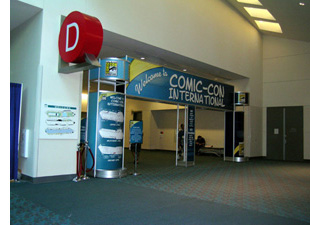 was speedy, with the barcode read and a badge generated and slipped into its plastic case in the blink of an eye. There were no events scheduled that night. It was simply an opportunity to get a look at the exhibition hall, with its thousands of booths and, in the case of the big companies, display areas. Familiar logos were everywhere, and the place stretched out further than one can see.
was speedy, with the barcode read and a badge generated and slipped into its plastic case in the blink of an eye. There were no events scheduled that night. It was simply an opportunity to get a look at the exhibition hall, with its thousands of booths and, in the case of the big companies, display areas. Familiar logos were everywhere, and the place stretched out further than one can see.
I mostly spent the evening checking out the companies related to The Lord of the Rings: Weta Workshop, Sideshow Collectibles, and the tiny booth shared by TheOneRing.net andSlave Boy Films (which produces fan-related video, mainly for websites). I was to do three one-hour signings there in the course of the Con, and it became my pied à terre for the duration of the event. (Thanks to producer Justin Sewell and his team for their hospitality!) I also visited the New Line display, but it was mainly there to sell DVDs of Harold and Kumar Escape from Guantanamo Bay. Sure, people could order it online, but the official release date wasn’t until July 29—two whole days after Comic-Con ended.
(I’ve written up an account of LOTR and The Hobbit at Comic-Con on my “Frodo Franchise” blog.)
Many types of activities go on simultaneously. There are continuous movie and television previews with stars, directors, and/or writers present. There are autographs to be had, with the most famous people signing in the Sails Pavilion (above) and others at booths in the exhibition hall. (I spotted Marcia Wallace, aka Mrs. Crabapple in The Simpsons, signing at one table.) There are things to be bought, though numerous small promotional items are given away. There are panels and artists’ lectures to attend. There are open spaces in which costumed fans can perform or pose for pictures. Aspiring comics artists can show their profiles to representatives from big publishers like Dark Horse. Gamers can try out previews of forthcoming games. Lots of socializing goes on. After the Harry Potter fandom panel ended, I saw the owners of The Leaky Cauldron meeting ardent fans whom they had only known online up to that point. In short, one cannot possibly do and see more than a small fraction of what happens.
Apart from my signing sessions, I concentrated on panels. I was afraid from the long line that I would get shut out of the “Masters of the Web” panel on Thursday morning, but I got in easily—and indeed, throughout the event I didn’t get shut out of anything, though I didn’t try often to get into the big Hollywood previews. The panels, by the way, start at the civilized hour of 10 am. Those of us taking the shuttle buses from distant hotels could still get up at a reasonable time, get breakfast, and make it to them.
Our TORN panel took place on Friday morning. Not everyone who wanted to attend could get into the 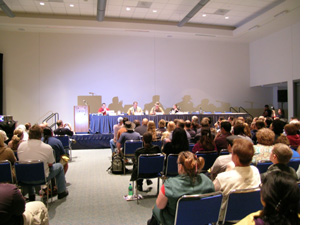 room. Apparently one fan who was shut out got unruly and had to be subdued by security staff! Those who did get in were an enthusiastic bunch, and we spent the session speculating on casting and on possible approaches to adapting The Hobbit and especially to writing the mysterious “Film 2” that is to create a “bridge” covering the sixty-year gap between The Hobbit and The Lord of the Rings. Judging from the applause, Martin Freeman (familiar in this country mainly as Declan in Shaun of the Dead) would be a popular choice for Bilbo. He does look like he would make a plausible hobbit. My suggestion of Mark Ruffalo for Thorin should definitely be taken seriously by the filmmakers.
room. Apparently one fan who was shut out got unruly and had to be subdued by security staff! Those who did get in were an enthusiastic bunch, and we spent the session speculating on casting and on possible approaches to adapting The Hobbit and especially to writing the mysterious “Film 2” that is to create a “bridge” covering the sixty-year gap between The Hobbit and The Lord of the Rings. Judging from the applause, Martin Freeman (familiar in this country mainly as Declan in Shaun of the Dead) would be a popular choice for Bilbo. He does look like he would make a plausible hobbit. My suggestion of Mark Ruffalo for Thorin should definitely be taken seriously by the filmmakers.
Other panels I attended involved the Disney “story process,” Sideshow and Marvel toys, and HP fandom. I heard Tolkien artist John Howe’s and comics master Lynda Barry’s talks, definitely two of the highlights of the Con for me. I had long loved John’s Tolkien illustrations and had corresponded with him during the writing of The Frodo Franchise, and it was a huge treat to get to meet him in person—and find that he had read and admired my book. Immediately we were talking like old friends.
Arriving early for Lynda’s talk, I sat through the end of a presentation on an animated series that I had never heard of. During this, Lynda came in and happened to sit down right next to me! (No one who has seen her self-portraits in her comics could fail to recognize her.) I hesitated to ask for her autograph, since some people don’t like to be bothered when they’re about to go onstage. When someone else asked and she didn’t seem to mind, I took my chance. I introduced myself as a fellow Wisconsinite, and she was most charming about signing my program. A good thing, too, since I didn’t figure out her schedule of autograph sessions at the Drawn and Quarterly table until after they were over.
The only disappointing panel was “The Culture of Popular Things: Ethnographic Examination of Comic-Con.” The panelists were a bunch of undergrads (and one grad students) doing a class project which consisted of interviewing exhibitors and fans on various subjects! I’m sure the students are smart and enthusiastic, but they didn’t belong on a panel. If Comic-Con organizers want to add an academic thread—and given the miniscule attendance at these events, I don’t see why they would—they should find some pop-culture experts to make up the panels.
[August 2: I have heard from Dr. Peter Coogan concerning my remarks on the panel “The Culture of Popular Things: Ethnographic Examination of Comic-Con 2008.” He offers some information about the Comic Arts Conference.
The CAC, which has been associated with the Comic-Con since 1992 and a formal part of the Comic-Con since 1998. We run four panels per day for over 20 hours of programming and are one of the largest programming tracks at Comic-Con. Last year the CAC was a small part of the successful argument that the Comic-Con made against San Diego’s attempt to get it reclassified as a for-profit corporation in terms of the rate it would be charged for city services.
Regarding attendance, the CAC was originally located down in room 17 (about 80 seats), but moved up to 7A (about 150 seats) after a few years, and last year to 30AB (about 200 seats). We have consistently filled or overfilled our space, and so have been rewarded with ever larger venues. Attendance was down at CAC panels this year, as it was at many non-media panels across the con. Because of the increased attendance at the con, the lines for the larger Hollywood panels have increased, and attendees, paradoxically, are less free to attend other panels because of all the time they spend waiting in lines.
No doubt I generalized too much on the basis of one panel, for which I apologize. More information on the CAC can be found at its Website.]
The exhibition hall, previews, and panels officially end at 7 pm. Films are screened at night, but I didn’t go to any of them. The main evening events are parties put on by big studios and manufacturers at hotels and screenings held by the studios in local movie theaters. I had a sample of each.
As a member of the TORN panel, I got invited to the Gentle Giant/ Lucasfilm/ Weta/ Sideshow party on Friday evening. I expected that there would be some sort of promotion for upcoming films and products, but there wasn’t anything at the party itself. An adjacent room held a large stack of swag-bags, but I didn’t think I would want to haul home most of what was in them, so I never found out what they contained. I had another chance to talk with John Howe, then briefly with Richard Taylor, and then went off to get a solid eight hours in preparation for the next day.
One of the films being shown in its entirety was Hamlet 2. Our good friend James Shamus of Focus Features got me onto the VIP/Press list, so on Saturday night I was off to the Gaslamp 15 multiplex. The film, which was a hit at Sundance this year, is an amusing and cheerily offensive film which has the potential to be one of this year’s indie sleepers. Director-writer Andrew Fleming, co-writer Pam Brady, and star Steve Coogan were there for a Q&A after the screening. It was definitely a more relaxed and personal session than the one I witnessed for a big studio films, where the guests were tiny dots in the distance and had to be viewed on giant TV screens.
That one preview and Q&A that I witnessed was for Terminator Salvation, which I had sort of assumed that I would miss. I had been avoiding the giant Hall H, where the big studios held their promotional events, because I had heard horror stories about hours waiting in line for one of the 6500 seats. There was plenty to do elsewhere. But I definitely wanted to see the 2:30 Pixar presentation of scenes from upcoming features Bolt and Up. That was at I decided to go early and get in the Pixar line just after Terminator Salvation started at 1:15.
It turned out that there was in fact just one line for Hall H, moving continuously as seats became available. This makes it difficult to gauge when to queue up for a specific event. That line snaked from the entrance across the plaza and made several long loops across the grass. Some people had settled in for lunch. But at about 1:20 we began to move surprisingly quickly. Turned out that the Terminator Salvation show was running a bit late, and I made it just as the preview reel started. It looked like it might be good, though my ears hurt for two days afterward (especially since they showed it again at the end). Director McG and some of the actors held a Q&A afterward—mostly the usual stuff about how wonderful it was to be working with each other. The high point came when a young Asian-American man from the audience asked a question in a perfect “Arnold” voice. He was called up to the stage to help field questions, keeping up the Arnold imitation flawlessly. By the way, Christian Bale (starring as John Connor) wasn’t there, though maybe if he had showed up, he could have avoided a spot of trouble he got into in London a few days earlier.
The Pixar session was a double preview. Co-directors Byron Howard and Chris Williams introduced some lengthy clips from Bolt, to be released November 26. It’s about a dog who plays a super-dog on TV and thinks he really has super powers. The footage cut together storyboard images, unrendered animation, and finished shots, which the audience didn’t seem to mind in the slightest. We’re used to seeing DVD supplements on pre-viz or storyboarding, but to see them all mixed together and edited into sequence, the way the filmmakers themselves see them during post-production, is a rare treat.
Then it was co-director Peter Docter’s turn to introduce Up. This sounds like one of the odder Pixar premises: a 78-year-old man avoids life in a nursing home by tying a giant bunch of helium balloons to his house and flies it to South America, discovering a stowaway boy and ending up in the jungle. The footage shown looked charming. Up is due out May 29. What with WALL-E this summer and these two coming soon, it looks like Pixar is managing to pick up the pace of production to more than one feature per year.
Hall H is essentially impossible to photograph. It’s too dark to shoot without flash, and flash only lights up a small area. To give a sense of scale, though, that orange rectangle near the center of the photo is the stage where the celebrities sit for their sessions. Sitting near the back, I could see them only as small dots, except on the monitors.
On Sunday I wandered around the exhibition hall, which I hadn’t really explored up to then. It’s divided into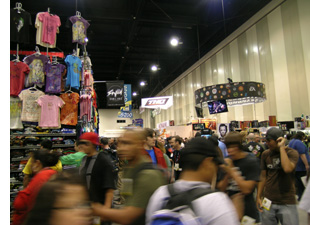 general sections by type of display. There’s an aisle for upcoming video games; that round thing in the photo at the right is the Electronic Arts sign. Gamers crowded it to try out the new titles. Artists’ Alley is where independent artists and aspiring artists can rent small display tables. Despite the proliferation of media publicized and sold at Comic-Con, comics still command a substantial portion of the floor. Dealers may offer old comics, original artwork, animation cels, and posters. Henry was delighted to find and purchase an original newspaper page with a well-preserved Winsor McCay comic-strip on it.
general sections by type of display. There’s an aisle for upcoming video games; that round thing in the photo at the right is the Electronic Arts sign. Gamers crowded it to try out the new titles. Artists’ Alley is where independent artists and aspiring artists can rent small display tables. Despite the proliferation of media publicized and sold at Comic-Con, comics still command a substantial portion of the floor. Dealers may offer old comics, original artwork, animation cels, and posters. Henry was delighted to find and purchase an original newspaper page with a well-preserved Winsor McCay comic-strip on it.
The big studios have large display areas for films and TV shows. Aisles around them seemed always to be choked with people, I gather getting autographs from cast members. I never did get close enough for a good look, but obviously these booths are very popular.
Action and collectible figures are represented, there’s an area for comic and graphic-novel publishers, such as Drawn and Quarterly.
Overall I enjoyed Comic-Con. I don’t think it will be one of those events I long to attend every year, but I would like to go back. Presumably in a year or two publicity for The Hobbit will start showing up at the Con, and that I definitely would like to see.












